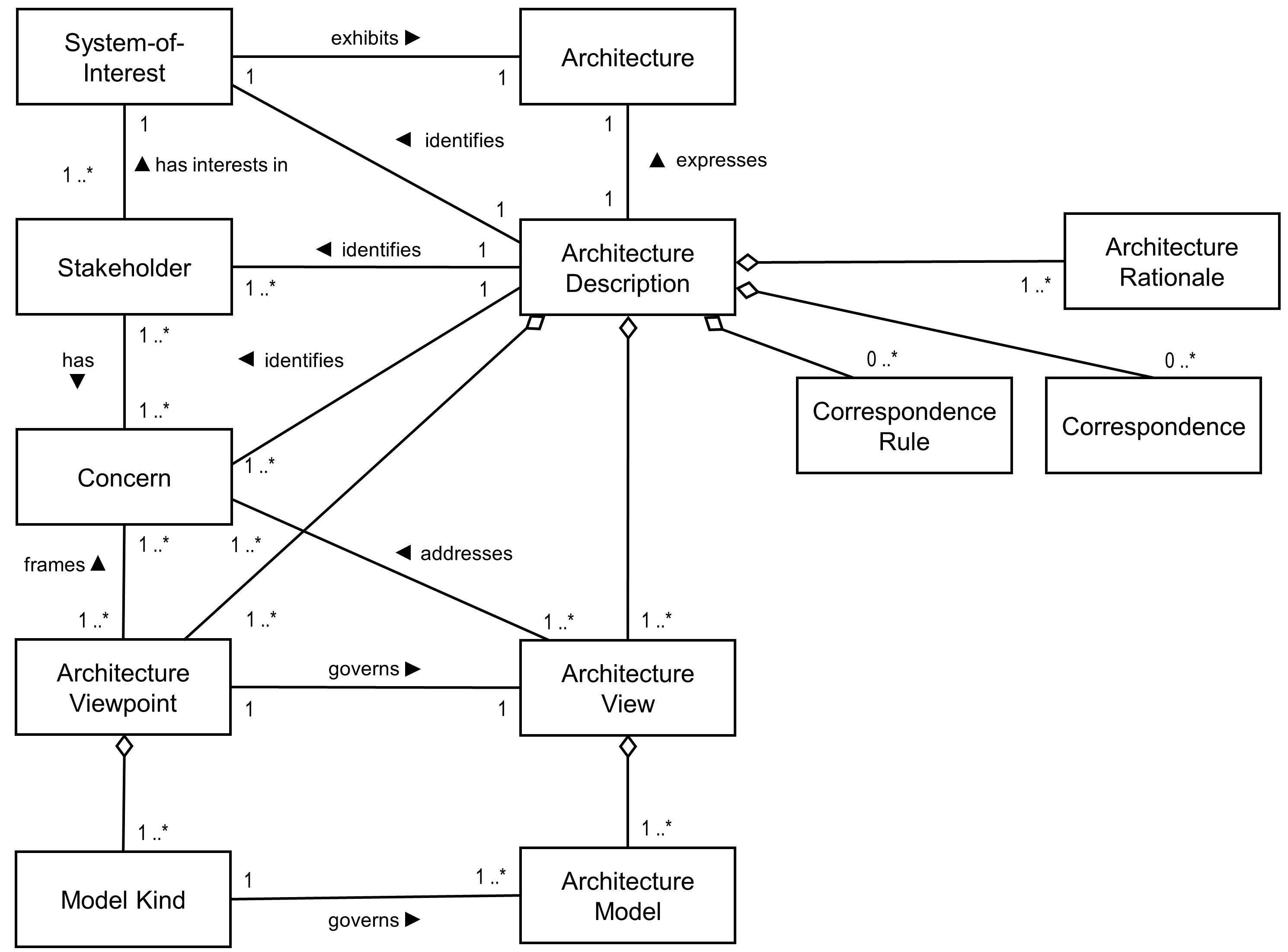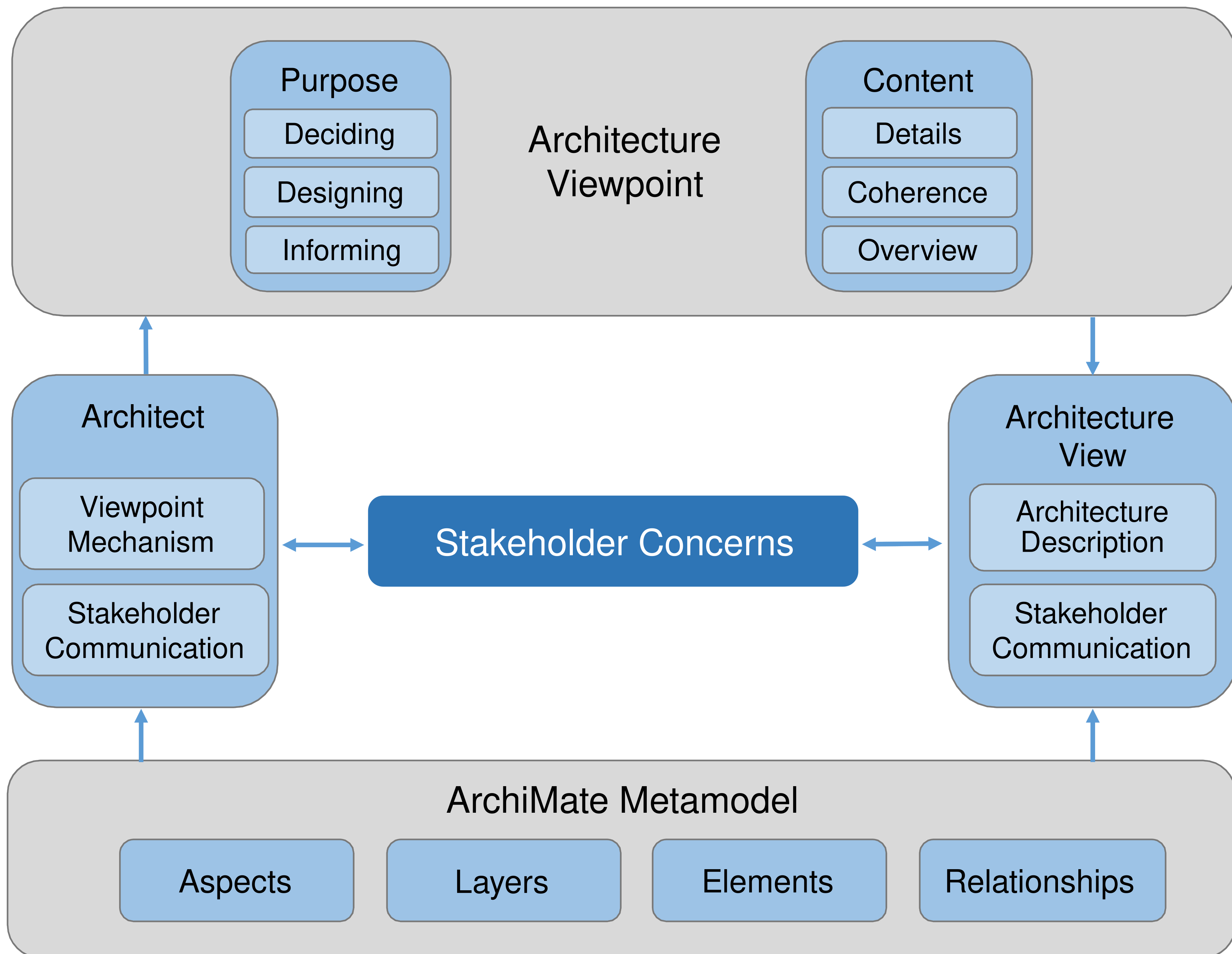13. Stakeholders, Architecture Views, and Viewpoints
13.1. Introduction
Establishing and maintaining a coherent Enterprise Architecture is clearly a complex task, because it involves many different people with differing backgrounds using various notations. In order to get a handle on this complexity, researchers have initially focused on the definition of architectural frameworks for classifying and positioning the various architectural descriptions with respect to each other (e.g., the Zachman framework [5], [8]).
Architecture frameworks provide general guidance to deliver Architecture Descriptions along with a process. The ArchiMate language, as a modeling notation, provides a detailed insight into the structure and coherence of different architectures, so its use complements and supports architecture frameworks.
The ArchiMate language provides a flexible approach in which architects and other stakeholders can use their own views on the Enterprise Architecture. In this approach, architecture views are specified by architecture viewpoints. Architecture viewpoints define abstractions on the set of models representing the Enterprise Architecture, each aimed at a particular type of stakeholder and addressing a particular set of concerns. Viewpoints can be used to view certain aspects in isolation, and to relate two or more aspects.
In the domain of Enterprise Architecture, the TOGAF framework describes a taxonomy of architecture views for different categories of stakeholders. In addition to this description of views, the TOGAF framework also provides guidelines for the development and use of architecture viewpoints and views in Enterprise Architecture models.
The architecture viewpoints and views proposed by any of the above-mentioned frameworks should not be considered in isolation: views are inter-related and, often, it is exactly a combination of views together with their underlying inter-dependency relationships that is the best way to describe and communicate a piece of architecture. It should, however, be noted that viewpoints and views have a limiting character. They are eventually a restriction of the whole system (and architecture) to a partial number of aspects – a view is just a partial incomplete depiction of the system.
13.2. Stakeholders and Concerns
This chapter introduces a method for using the ArchiMate language to systematically address stakeholder concerns, the viewpoint mechanism. This viewpoint mechanism conforms to the ISO/IEC 42010 standard [14], which provides a model for Architecture Description. Stakeholders, concerns, viewpoints, and views are important elements in this model, as depicted in Figure 34.

The ArchiMate language with the viewpoint mechanism described in Section 13.4 assists and guides the architect in definition and classification of governing viewpoints. The architect will use this mechanism in their work to construct and design views for stakeholder communication.
13.3. Architecture Views and Viewpoints
Architecture views are an ideal mechanism to purposefully convey information about architecture areas. In general, a view is defined as a part of an Architecture Description that addresses a set of related concerns and is tailored for specific stakeholders. A view is specified by means of an architecture viewpoint, which prescribes the concepts, models, analysis techniques, and visualizations that are provided by the view. Simply put, a view is what you see, and a viewpoint is where you are looking from.
An Architecture Description includes one or more architecture views. An architecture view (or simply “view”) addresses one or more of the concerns held by a stakeholder of the system.
An architecture view expresses the architecture of the system of interest in accordance with an architecture viewpoint (or simply “viewpoint”). There are two aspects to a viewpoint: the concerns it frames for the stakeholders and the conventions it establishes on views.
An architecture viewpoint frames one or more concerns. A concern can be framed by more than one viewpoint.
A view is governed by its viewpoint: the viewpoint establishes the conventions for constructing, interpreting, and analyzing the view to address concerns framed by that viewpoint. Viewpoint conventions can include languages, notations, model kinds, design rules and/or modeling methods, analysis techniques, and other operations on views.
Architecture viewpoints are a means to focus on particular aspects and layers of the architecture. These aspects and layers are determined by the concerns of a stakeholder with whom communication takes place. What should and should not be visible from a specific viewpoint is therefore entirely dependent on the argumentation with respect to a stakeholder’s concerns.
Viewpoints are designed for the purpose of communicating certain aspects and layers of an architecture. The communication enabled by a viewpoint can be strictly informative, but in general is bi-directional. The architect informs stakeholders, and stakeholders give their feedback (critique or consent) on the presented aspects and layers. What is and what is not shown in an architecture view depends on the scope of the viewpoint and on what is relevant to the concerns of the stakeholder. Ideally, these are the same; i.e., the viewpoint is designed with specific concerns of a stakeholder in mind. Relevance to a stakeholder’s concern, therefore, is the selection criterion that is used to determine which elements and relationships are to appear in a view.
13.4. Viewpoint Mechanism
An architect is confronted with many different types of stakeholders and concerns. To help in selecting the right viewpoints for the task at hand, we introduce a framework for the definition and classification of viewpoints: the viewpoint mechanism. The framework is based on two dimensions: purpose and content. Figure 115 shows how the viewpoint mechanism is used to create views addressing stakeholder concerns.

The architect communicates with the stakeholder to understand and document their concerns. The viewpoint mechanism is used to identify purpose and content and to help define and classify the viewpoint. The viewpoint governs the construction and design of the view. The view is a description of the architecture addressing stakeholder concerns and is governed by the viewpoint.
Creating an ArchiMate viewpoint consists of two steps:
-
Selecting a subset of relevant concepts (elements and relationships) from the ArchiMate metamodel, based on the information that is needed to address the stakeholder’s concerns.
-
Defining a representation to depict these concepts in a way that is understood by the stakeholders. This can be a diagram that uses standard or customized ArchiMate notation, a catalog of elements, a matrix showing the relationships between two groups of elements, or an entirely different visualization.
Applying this viewpoint to an architecture model means that those parts of the architecture are selected that match the chosen set of concepts (Step 1) and are depicted in the manner prescribed by Step 2.
13.4.1. Defining and Classifying Viewpoints
To help define and classify viewpoints based on a repeatable structure, the ArchiMate language assists the architect in selecting purpose and content relevant for the stakeholder’s concerns.
The purpose dimension is supported by the following three categories:
-
Designing: design viewpoints support architects and designers in the design process from initial sketch to detailed design
Typically, design viewpoints consist of diagrams.
-
Deciding: decision support viewpoints assist managers in the process of decision-making by offering insight into cross-domain architecture relationships, typically through projections and intersections of underlying models, but also by means of analytical techniques
Typical examples are cross-reference tables, landscape maps, lists, and reports.
-
Informing: informing viewpoints help to inform any stakeholder about the Enterprise Architecture, in order to achieve understanding, obtain commitment, and convince adversaries
Typical examples are illustrations, animations, cartoons, flyers, etc.
The content dimension uses the ArchiMate Core Framework to select relevant aspects and layers. This is supported by the following three categories:
-
Details: views on the detailed level typically consider one layer and one aspect from the ArchiMate Core Framework
Typical stakeholders are a software engineer responsible for design and implementation of a software component or a process owner responsible for effective and efficient process execution.
-
Coherence: at the coherence abstraction level, multiple layers or multiple aspects are spanned
Extending the view to more than one layer or aspect enables the stakeholder to focus on architecture relationships like process-uses-system (multiple layer) or application-uses-object (multiple aspect). Typical stakeholders are operational managers responsible for a collection of IT services or business processes.
-
Overview: the overview abstraction level addresses both multiple layers and multiple aspects
Typically, such overviews are addressed to Enterprise Architects and decision-makers, such as CEOs and CIOs.
13.4.2. Creating the View
With a governing viewpoint, the architect can create and design a view. The view contains elements and relationships (concepts) from the ArchiMate metamodel. The architect can design and create an appropriate representation for these elements and relationships, suitable for the stakeholder(s) and concern(s) being framed. The architect may use the profile mechanism described in Section 14.1 to create representations based on attributes of elements and relationships; for example, to create color-coded heat maps. The view does not have to be visual or graphical in nature.
13.5. Example Viewpoints
See Appendix C for a set of example viewpoints.